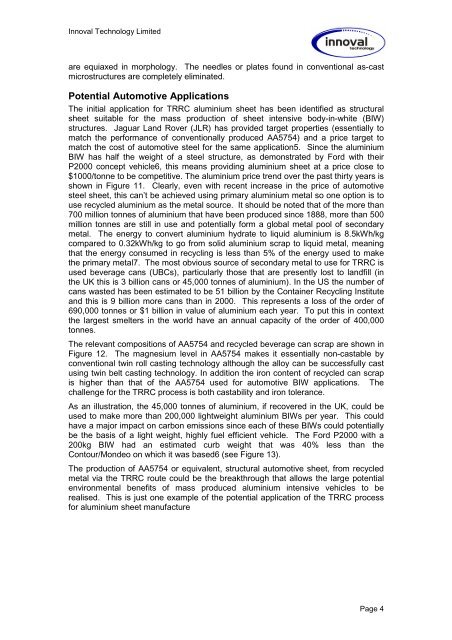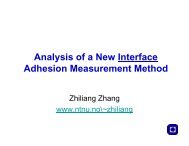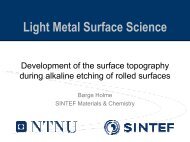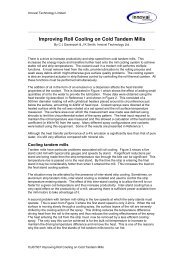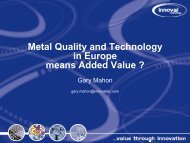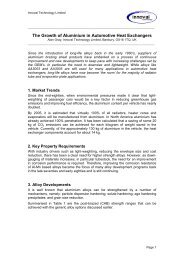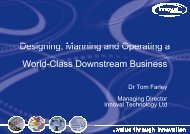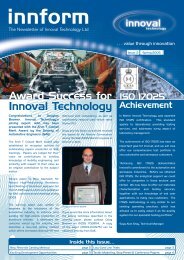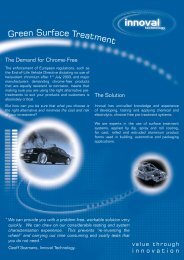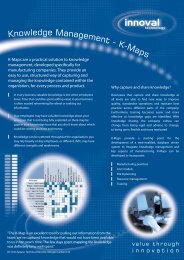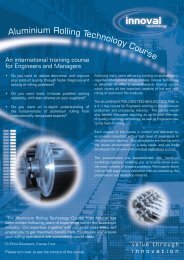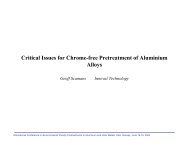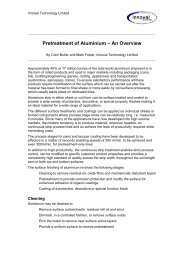Twin Roll Rheocasting of Aluminium Alloys - Innoval Technology Ltd
Twin Roll Rheocasting of Aluminium Alloys - Innoval Technology Ltd
Twin Roll Rheocasting of Aluminium Alloys - Innoval Technology Ltd
Create successful ePaper yourself
Turn your PDF publications into a flip-book with our unique Google optimized e-Paper software.
<strong>Innoval</strong> <strong>Technology</strong> Limited<br />
are equiaxed in morphology. The needles or plates found in conventional as-cast<br />
microstructures are completely eliminated.<br />
Potential Automotive Applications<br />
The initial application for TRRC aluminium sheet has been identified as structural<br />
sheet suitable for the mass production <strong>of</strong> sheet intensive body-in-white (BIW)<br />
structures. Jaguar Land Rover (JLR) has provided target properties (essentially to<br />
match the performance <strong>of</strong> conventionally produced AA5754) and a price target to<br />
match the cost <strong>of</strong> automotive steel for the same application5. Since the aluminium<br />
BIW has half the weight <strong>of</strong> a steel structure, as demonstrated by Ford with their<br />
P2000 concept vehicle6, this means providing aluminium sheet at a price close to<br />
$1000/tonne to be competitive. The aluminium price trend over the past thirty years is<br />
shown in Figure 11. Clearly, even with recent increase in the price <strong>of</strong> automotive<br />
steel sheet, this can’t be achieved using primary aluminium metal so one option is to<br />
use recycled aluminium as the metal source. It should be noted that <strong>of</strong> the more than<br />
700 million tonnes <strong>of</strong> aluminium that have been produced since 1888, more than 500<br />
million tonnes are still in use and potentially form a global metal pool <strong>of</strong> secondary<br />
metal. The energy to convert aluminium hydrate to liquid aluminium is 8.5kWh/kg<br />
compared to 0.32kWh/kg to go from solid aluminium scrap to liquid metal, meaning<br />
that the energy consumed in recycling is less than 5% <strong>of</strong> the energy used to make<br />
the primary metal7. The most obvious source <strong>of</strong> secondary metal to use for TRRC is<br />
used beverage cans (UBCs), particularly those that are presently lost to landfill (in<br />
the UK this is 3 billion cans or 45,000 tonnes <strong>of</strong> aluminium). In the US the number <strong>of</strong><br />
cans wasted has been estimated to be 51 billion by the Container Recycling Institute<br />
and this is 9 billion more cans than in 2000. This represents a loss <strong>of</strong> the order <strong>of</strong><br />
690,000 tonnes or $1 billion in value <strong>of</strong> aluminium each year. To put this in context<br />
the largest smelters in the world have an annual capacity <strong>of</strong> the order <strong>of</strong> 400,000<br />
tonnes.<br />
The relevant compositions <strong>of</strong> AA5754 and recycled beverage can scrap are shown in<br />
Figure 12. The magnesium level in AA5754 makes it essentially non-castable by<br />
conventional twin roll casting technology although the alloy can be successfully cast<br />
using twin belt casting technology. In addition the iron content <strong>of</strong> recycled can scrap<br />
is higher than that <strong>of</strong> the AA5754 used for automotive BIW applications. The<br />
challenge for the TRRC process is both castability and iron tolerance.<br />
As an illustration, the 45,000 tonnes <strong>of</strong> aluminium, if recovered in the UK, could be<br />
used to make more than 200,000 lightweight aluminium BIWs per year. This could<br />
have a major impact on carbon emissions since each <strong>of</strong> these BIWs could potentially<br />
be the basis <strong>of</strong> a light weight, highly fuel efficient vehicle. The Ford P2000 with a<br />
200kg BIW had an estimated curb weight that was 40% less than the<br />
Contour/Mondeo on which it was based6 (see Figure 13).<br />
The production <strong>of</strong> AA5754 or equivalent, structural automotive sheet, from recycled<br />
metal via the TRRC route could be the breakthrough that allows the large potential<br />
environmental benefits <strong>of</strong> mass produced aluminium intensive vehicles to be<br />
realised. This is just one example <strong>of</strong> the potential application <strong>of</strong> the TRRC process<br />
for aluminium sheet manufacture<br />
Page 4


